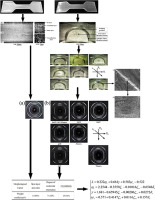当前位置:
X-MOL 学术
›
Polym. Test.
›
论文详情
Our official English website, www.x-mol.net, welcomes your
feedback! (Note: you will need to create a separate account there.)
Study on mechanical properties of co-injection self-reinforced single polymer composites based on micro-morphology under different molding parameters
Polymer Testing ( IF 5.0 ) Pub Date : 2020-03-01 , DOI: 10.1016/j.polymertesting.2019.106306 Yong Lu , Kaiyu Jiang , Yuying Liu , Yan Zhang , Minjie Wang
Polymer Testing ( IF 5.0 ) Pub Date : 2020-03-01 , DOI: 10.1016/j.polymertesting.2019.106306 Yong Lu , Kaiyu Jiang , Yuying Liu , Yan Zhang , Minjie Wang

|
Abstract Self-reinforced single polymer composites (SRCs), which are fabricated by combining the same type of polymer with different properties into one body, have high specific strength, no interfacial heterogeneity, and ease of recycling. To better understand the relationship between the micro-morphology and mechanical properties of SRCs, the co-injection molding process was used in this study to process SRCs parts with different molding parameters and obtain the co-injection self-reinforced single polymer composites parts(CI-SRCs parts). Further, the micro-morphology of CI-SRCs parts were observed by polarizing microscope (PLM), scanning electron microscope (SEM), differential scanning calorimetry (DSC) and wide Angle X-ray diffraction (WAXD). From the results, it was found that the tensile properties of CI-SRCs parts with different molding parameters were improved by up to 23.94% compared with the conventional parts. Through PLM observation, it is found that the section shape of CI-SRCs parts perpendicular to the flow direction shows a double ‘skin-core’ structure, and the area ratio of skin layer was higher than that of conventional parts, with a maximum increase of 68%. The low-temperature and low-speed environment were conducive to the formation of skin layer, and the tensile property of CI-SRCs parts were positively correlated with the area ratio of skin layer. SEM was carried out on the skin layer near the fusion position of the interface, and the highly oriented ‘shish-kebab’ structure was observed. The 1D-WAXD pattern analysis shows that the crystallinity of CI-SRCs parts were lower than that of conventional parts, with a maximum reduction of 19.32%. The crystallinity of CI-SRCs parts were positively correlated with melt temperature gradient, and its tensile properties were negatively correlated with the change of crystallinity. The 2D-WAXD pattern analysis shows that the molecular orientation of CI-SRCs parts were higher than conventional parts, with the maximum increase of 37.44%. Low temperature and low speed can improve the molecular orientation of CI-SRCs parts, and the change of molecular orientations were positively correlated with the tensile properties of CI-SRCs parts. By means of response surface method, the molecular orientation obtained was the decisive factor affecting the performance of CI-SRCs parts. Furthermore, by means of the least squares minimization program, the dimensionless equations among molding parameters, micro-morphologies and mechanical properties were established. The prediction of mechanical properties of CI-SRCs parts based on micro-morphologies were realized, providing theoretical support for the ‘adjustability’ of CI-SRCs parts properties.
中文翻译:

基于微观形貌的共注射自增强单体聚合物复合材料不同成型参数下的力学性能研究
摘要 自增强单聚合物复合材料(SRCs)是由同种不同性质的聚合物复合而成,具有比强度高、界面不均匀、易于回收利用等优点。为了更好地理解SRCs的微观形貌与力学性能之间的关系,本研究采用共注射成型工艺加工不同成型参数的SRCs零件,获得共注射自增强单聚合物复合材料零件(CI)。 -SRC 部分)。此外,通过偏光显微镜(PLM)、扫描电子显微镜(SEM)、差示扫描量热法(DSC)和广角X射线衍射(WAXD)观察CI-SRCs部件的微观形貌。从结果来看,结果表明,不同成型参数的CI-SRCs零件的拉伸性能比常规零件提高了23.94%。通过PLM观察发现CI-SRCs零件垂直于流动方向的截面形状呈现双“皮芯”结构,皮层面积比高于常规零件,增加幅度最大68%。低温低速环境有利于表层的形成,CI-SRCs零件的拉伸性能与表层面积比呈正相关。对界面融合位置附近的表层进行扫描电镜观察,观察到高度定向的“shish-kebab”结构。1D-WAXD图谱分析表明,CI-SRCs零件的结晶度低于常规零件,最大降低19.32%。CI-SRCs零件的结晶度与熔体温度梯度呈正相关,其拉伸性能与结晶度的变化呈负相关。2D-WAXD图谱分析表明,CI-SRCs零件的分子取向高于常规零件,最大提高了37.44%。低温低速可以改善CI-SRCs零件的分子取向,分子取向的变化与CI-SRCs零件的拉伸性能呈正相关。通过响应面法,获得的分子取向是影响CI-SRCs零件性能的决定性因素。此外,通过最小二乘最小化程序,建立了成型参数、微观形貌和力学性能之间的无量纲方程。实现了基于微观形貌对CI-SRCs零件力学性能的预测,为CI-SRCs零件性能的“可调性”提供了理论支持。
更新日期:2020-03-01
中文翻译:

基于微观形貌的共注射自增强单体聚合物复合材料不同成型参数下的力学性能研究
摘要 自增强单聚合物复合材料(SRCs)是由同种不同性质的聚合物复合而成,具有比强度高、界面不均匀、易于回收利用等优点。为了更好地理解SRCs的微观形貌与力学性能之间的关系,本研究采用共注射成型工艺加工不同成型参数的SRCs零件,获得共注射自增强单聚合物复合材料零件(CI)。 -SRC 部分)。此外,通过偏光显微镜(PLM)、扫描电子显微镜(SEM)、差示扫描量热法(DSC)和广角X射线衍射(WAXD)观察CI-SRCs部件的微观形貌。从结果来看,结果表明,不同成型参数的CI-SRCs零件的拉伸性能比常规零件提高了23.94%。通过PLM观察发现CI-SRCs零件垂直于流动方向的截面形状呈现双“皮芯”结构,皮层面积比高于常规零件,增加幅度最大68%。低温低速环境有利于表层的形成,CI-SRCs零件的拉伸性能与表层面积比呈正相关。对界面融合位置附近的表层进行扫描电镜观察,观察到高度定向的“shish-kebab”结构。1D-WAXD图谱分析表明,CI-SRCs零件的结晶度低于常规零件,最大降低19.32%。CI-SRCs零件的结晶度与熔体温度梯度呈正相关,其拉伸性能与结晶度的变化呈负相关。2D-WAXD图谱分析表明,CI-SRCs零件的分子取向高于常规零件,最大提高了37.44%。低温低速可以改善CI-SRCs零件的分子取向,分子取向的变化与CI-SRCs零件的拉伸性能呈正相关。通过响应面法,获得的分子取向是影响CI-SRCs零件性能的决定性因素。此外,通过最小二乘最小化程序,建立了成型参数、微观形貌和力学性能之间的无量纲方程。实现了基于微观形貌对CI-SRCs零件力学性能的预测,为CI-SRCs零件性能的“可调性”提供了理论支持。











































 京公网安备 11010802027423号
京公网安备 11010802027423号